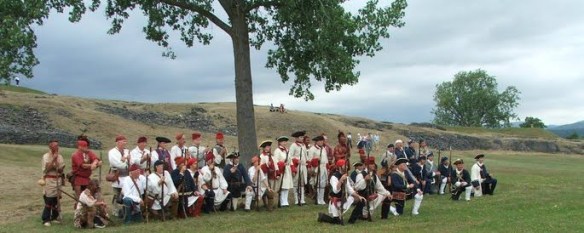Jean-Baptiste Levrault de Langis Montgeron (known as “Langy” in English) was considered the ideal French-Canadian leader, who allowed New France to defy the odds as long as it did.
Langy was born in 1723 and followed in the footsteps of his father and three older brothers by serving in the colonial regular troops. He began his military career on Cape Breton Island, and in 1755, as an ensign, participated in the unsuccessful defence of Fort Beauséjour. During this campaign his superiors identified him as “an extraordinarily brave officer.”
Langy became a key player on the Lake Champlain–Lake George front. He was continually raiding, scouting, and gathering intelligence. His forays took him deep into enemy territory, where his attacks left the British unnerved and consistently on the defensive. The information Langy brought back on enemy fortifications and/or their intentions (drawn from prisoners) kept the French well informed. Throughout the spring of 1758, Langy was constantly in the field attempting to determine the English intentions. Although seizing many prisoners, no useful information was discovered. Then, in June, Langy captured 17 Rangers, who revealed an impending attack against the strategic Fort Ticonderoga. On July 4, Montcalm, demonstrating his confidence in the Canadian partisan leader, trusted Langy “to go observe the location, number, and the movements of the enemy.” Langy’s force departed and returned the following night with news that the British invasion force was en route. As a result, Montcalm ordered his troops to take up defensive positions.
However, Langy’s job was not finished. He deployed once again to monitor the British advance. On July 7 he had a chance encounter with the British advance guard. In the bloody clash that followed, both sides suffered substantial casualties. Langy’s men killed Brigadier Lord Howe during the skirmish. With his death the British suffered a critical loss of leadership that doomed their attack. Although outnumbered almost four to one, Montcalm went on to route Major-General James Abercromby’s army.
As the tide of the war changed, Langy remained instrumental in harassing the English forces, particularly the British Rangers who had begun burning homesteads of les habitants during the siege of Quebec City. He also crossed swords with Major Rogers on two more occasions. On the first, he discovered whaleboats that were used by Rogers and 142 Rangers for their raid on the Abenaki village of St. Francis. The subsequent pursuit ended with 69 Rangers dead or captured and the others narrowly escaping with their lives. The second encounter was even more successful. Despite the fall of Quebec in September 1759, Langy, operating from Îsle aux Noir (near Montreal), continued his aggressive raids. In February 1760, as Rogers was en route to Crown Point from Albany, his convoy of sleds was ambushed by Langy. Recognizing Rogers in the first sled, Langy focused his attack there. The initial volley killed the horses and Langy’s force pounced on Rogers and his 16 recruits. In the ensuing melee, Rogers and seven others escaped to Crown Point. The other nine Rangers were killed or captured. Langy also seized 32 brand-new muskets, 100 hatchets, 55 pairs of moccasins, and ₤3,961 — the payroll for the troops at Crown Point.
His final raid was conducted six weeks later, once again near Crown Point. Representative of his skill and daring, Langy was able to capture two British regular officers, a Ranger officer, and six troops, without a firing shot. His luck, however, had run out. Shortly after his return to Montreal with his prisoners, Langy drowned while trying to cross the St. Lawrence River in a canoe. Captain Pierre Pouchot noted the news in his journal, commenting that Langy was “the best leader among the colonial troops.” An English newspaper also reflected that assessment, “Mons. Longee, a famous partisan, fell through the ice sometime and was drowned … his loss is greatly lamented by all Canada, and his equal is not to be found in that country.”
